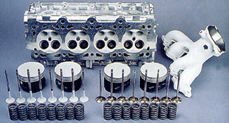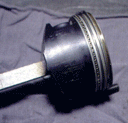Dare to Compare, Swain Tech’s Coating Make Car 1 Second Per Lap Faster
Written by Mike Mavrigian
PROJECT HISTORY
It started out as an idea: to prepare two late-model small-displacement production engines, and to endurance test these engines in a 24-hour road race. The goal: to find out, based on initial build parameters, what happens to the engines after 24-hours of wide-open-throttle abuse.
In order to accomplish the goals of the project, we used two Dodge Neons, both 4-door versions equipped with the Chrysler 2.0L SOHC 4-cylinder engine. Aside from camshaft profile and a few updated part numbers for various engine sensors, these two motors were identical.
Dare to Compare Coated Parts
Swain Tech Coatings supplied specialty coatings to the head, valve train, pistons and exhaust manifold.
Dare to Compare Used Piston
After a grueling 24 hour race and two sprint races the bores and rings looked incredibly good and almost like new. The Poly Moly™ coated skirt show only minor signs of scuffing on the thrust sides and rods showed no flaws and no dimensional shifts.
We started by building our test platforms, which involved race-prepping the two Neons to SCCA show-room stock rules. SCCA rules state that you are permitted to “balance” the engine. You can’t use a bigger piston, you can’t change the cam, you can’t change port sizes, etc. As far as blueprinting is concerned, this is a gray area. In essence, you can inspect/rebuild the motor, as long as no obvious “machining” marks are created that would “enhance” performance.
Both engines were built and improved within the SCCA rules with the only major difference between the two engine builds was in terms of internal coatings. One engine was sent to Swain Tech Coatings for internal coatings and the other was left uncoated.
COATINGS
Swain Tech Coatings applied three specialized coatings; TBC™ (Thermal Barrier Coating), Poly Moly™ (low friction, self lubricating) and BBE™ (Black Body Emitter). The TBC ceramic coating was applied to the piston domes, combustion chambers, the faces of all four valves in each chamber, the backside of the eight exhaust valves, and inside the cast iron exhausts manifold runners.
The ceramic coating serves as a thermal barrier, or heat shield. Since the piston domes were ceramic coated, this prevents combustion heat from soaking into the alloy pistons, preventing them from expanding thermally as they would normally do during operation. This allows a tighter piston to bore clearance to be obtained in addition to maintaining a more consistent piston dimension. The TBC on the chambers and valve faces also serves to keep the combustion heat in the chamber, where it can do its work, instead of soaking through the head. On its way out, exhaust gasses/heat are evacuated more efficiently as they pass through the exhaust ports and out the exhaust manifold. The theory is to capture the heat in order to make horsepower, and then get rid of it without losing a bunch of heat through heat-soaking into the head. The ceramic coating on the exhaust manifold has another benefit: since it creates a heat barrier, the exterior temperature of the exhaust manifold is reduced. Heat makes horsepower, and this coating keeps the heat where it belongs, instead of wasting it by soaking through the metal components.
The piston skirts were coated with Poly Moly™, a friction reducing coating. Whenever the skirts do contact the bore walls, the moly coating allows the skirts to easily slip over the lubed bore walls. We noticed a big difference during assembly as the crank was rotated. The Poly Moly coated pistons slipped through with MUCH greater ease than did the uncoated pistons in the uncoated motor.
The valve springs were coated with a low friction, heat emitting coating. The concept is to shed heat quickly and it appears to work. In case of valve spring applications, this coating prevents the springs from heat soaking and tiring. After 24 hours of full-throttle use, the coatings remained in place with no flaking or other problems.
RESULTS
We began testing in July, by running the engines in a truly stock form, simply to establish a baseline of reference. At the first outing at Pocono, the cars were tragically slow, running 8 seconds per lap off the pace, compared to the other cars in the class (many of which were Neons). This made it obvious some “enhancements” were needed.
With both motors “enhanced” within the SCCA rules, and the one motor internally coated by Swain, we were ready for our “grand finale” event, the 24-hour endurance race at Moroso Motorsports Park (West Palm Beach, Florida, January). We entered both cars in this event, and for the most part, things went extremely well. Our Swain Tech coated Neon won its class without experiencing a single glitch, and our uncoated car, though it ran well and finished the event, unfortunately had two non-engine problems.
The performance difference between the coated and uncoated engines was immediate and noticeable. During testing, qualifying and the race itself, the car with the coated motor was one second per lap faster. That’s power that you can take to the bank. We also found our uncoated motor, where bore clearance was greater, the piston rattled noticeably when cold, finally quieting down as the motor reached operating temperature. The coated motor, with slightly tighter bore and moly skirting, was completely quiet when cold, yet provided more power when at operating temperature.
I’m completely sold on this procedure. It reduces heat-soak, produces more power, friction is reduced and it didn’t flake off. We saw no downside to this whatsoever.
If you’ve ever wondered about the performance of this type of coating, you’re not alone. My crew chief and one of our endurance drivers were admittedly skeptical when I told them that one of our engines had been ceramic coated. After the race and after realizing that this engine was almost one full second per lap faster than the uncoated engine, both of these guys ate crow. “This stuff really works” was the comment made by my usually sarcastic crew chief.
TEARDOWN AND INSPECTION
The 2.0 SOHC engine in the team’s winning coated car was subjected to extreme accelerated abuse of winning a 24 hour race. At an average engine speed of 5,000 rpm (averaged throughout the course of the 24 hour race which includes shift points at 6,400 rpm as well as time allowed for pit stops), the engine was subjected to a total of approximately 7.2 million crankshaft revolutions during the race.
With the 24 hour race victory in hand, we took the coated Neon on to two “sprint” events without any problems. After putting the coated engine through this prolonged abuse, we completed a teardown to inspect the coated parts.
PISTONS
During the build, the OE pistons were used since no after market pistons are available for this motor and SCCA showroom stock rules don’t allow piston changes. The TBC ceramic coating applied by Swain to the domes and Poly Moly was applied to the skirts.
Inspection of the rings revealed they were in outstanding condition and still looked like new. None of the ring lands were damaged either. Aside from some carbon buildup on the domes (which would have been worse without the ceramic coating), the pistons were found to be in excellent condition.
The moly coated piston skirts showed only slight wear at the thrust lines, which would be expected. We’ll have the skirts recoated before this engine is reassembled just to be safe.
CYLINDER HEAD
The combustion chambers, exhaust ports, all valve faces, and the back-side of each exhaust valve were all initially coated with Swain Tech Coating’s TBC ceramic coating prior to the assembly of this motor. This thermal barrier allows combustion heat to work more efficiently and prevents thermal dissipation through the head, instead allowing more efficient heat evacuation through the exhaust stream.
Initial inspection made us think that some of the ceramic coating material had disappeared from the chambers and valves, since a smooth, almost shiny appearance was seen in isolated areas. However, the coating was indeed intact. If the coating had lifted, those surfaces would have appeared extremely rough since the prep involves extensive blasting to roughen the surfaces prior to coating. The texture and coloration of the ceramic coating simply changed, but the coating did retain its grip.
VALVE SPRINGS
This inspection provided a real surprise. Initially, the OE springs coated with Swain’s low friction, heat emitting coating, were measured at 85 lbs. closed and 185 lbs. open. The shocker was that when inspected during this teardown, all springs retained those initial pressures. In any case, the valve springs proved to survive the 699 laps of the 24-hour race as well as two sprint races, with no pressure changes whatsoever.
SUMMARY
Simply finishing a 24-hour race is an achievement, but winning 30 laps ahead of our closest competitor, and without a single problem in our winning coated car throughout the entire event, is a real testimony to our engine preparation, chassis prep, drivers, and our incredibly talented crew.
As far as our engine project is concerned, we are delighted with the progress that we made, and with the success at this grueling 24-hour event. The success is bolstered by the fact that so many of the other cars in other classes (Porsche 944s and BMWs in particular) experienced a myriad of overheating and clutch problems, while we simply zinged along, only needing scheduled replacement of tires and fuel. In all, this is a stout little motor with only a few long-term shortcomings, each of which is easily addressed.


